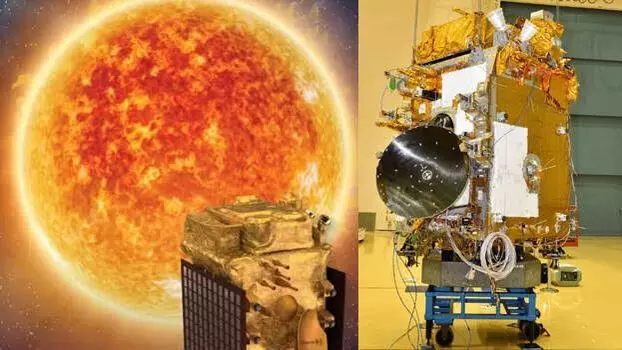Even `Sun’ is not the limit: Aditya-L1 sends selfie, images of Earth, Moon, Sun's Corona
Aditya-L1 is on a mission to reach the Sun-Earth L1 point, and the recent images were taken by its onboard camera on September 4, 2023
By Anoushka Caroline Williams
Representational Image
Hyderabad: Indian Space Research Organisation (ISRO) has shared a captivating "selfie" and images of the Earth, the Moon, and the Sun's Corona captured by the camera onboard the Aditya-L1 solar mission spacecraft.
These images mark the beginning of a remarkable journey that will see the spacecraft sending up to 1,440 images a day to the ground station for analysis.
Aditya-L1 is on a mission to reach the Sun-Earth L1 point, and the recent images were taken by its onboard camera on September 4, 2023.
The visuals provide a glimpse of the Visible Emission Line Coronagraph (VELC) and Solar Ultraviolet Imager (SUIT) instruments, two key payloads on Aditya-L1.
VELC, the primary payload developed by the Indian Institute of Astrophysics (IIA) in Bengaluru, is an internally occulted coronagraph. This instrument comprises 40 meticulously aligned optical elements, including mirrors and gratings.
VELC's purpose is to block out the intense light from the Sun's disk, enabling it to capture images of the much fainter solar corona, which is typically visible only during a total solar eclipse.
The VELC instrument is set to send an impressive 1,440 images per day to the ground station for in-depth analysis once Aditya-L1 reaches its intended orbit. It's worth noting that VELC represents one of the most challenging payloads on the Aditya-L1 mission and underwent integration, testing, and calibration at the IIA's CREST (Centre for Research and Education in Science Technology) campus in Hoskote, near Bengaluru, in collaboration with ISRO.
The Solar Ultraviolet Imager (SUIT) payload, developed by the Inter-University Centre for Astronomy and Astrophysics (IUCAA) in Pune, is another vital instrument on Aditya-L1. With these advanced instruments, the spacecraft is poised to provide crucial insights into the Sun's behavior and the dynamics of its corona.
The Aditya-L1 spacecraft was successfully launched by ISRO using its reliable PSLV-C57 rocket on September 2.
This remarkable mission carries a total of seven diverse payloads designed to study the Sun. Four of these payloads will observe solar light, while the remaining three will measure in situ parameters related to plasma and magnetic fields.
Aditya-L1 is destined for a halo orbit around Lagrangian Point 1 (L1), situated 1.5 million kilometers from Earth in the direction of the Sun.
This unique orbit will allow the spacecraft to maintain a continuous observation of the Sun, providing invaluable data for solar scientists and researchers.
The images shared by ISRO offer a glimpse into the exciting journey of the Aditya-L1 mission, promising a wealth of scientific discoveries about our nearest star, the Sun.
As the spacecraft embarks on this groundbreaking expedition, it holds the promise of unlocking new insights into the Sun's mysteries and deepening our understanding of the dynamic solar system.
The Aditya-L1 mission represents yet another testament to India's growing capabilities in space exploration and its dedication to advancing our knowledge of the cosmos.